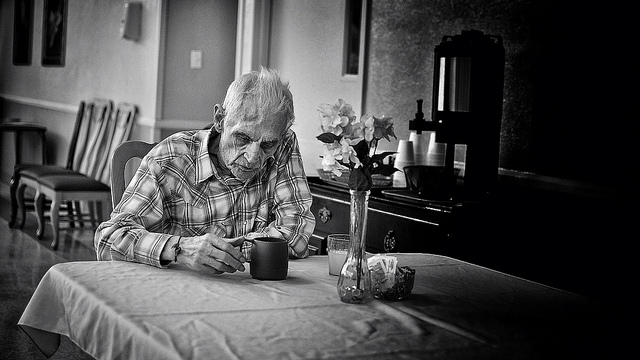
An overwhelming percentage of older adults insist on remaining in their homes as they age.
Called “aging in place,” it’s considered the Holy Grail for families and governments alike. Older adults want the comfort and autonomy of home. Governments hope to keep seniors at home as long as possible, mortified of the financial burden low-income seniors become when they move into nursing homes.
Yet aging experts are increasingly questioning this assumption. Many seniors living at home suffer from social isolation and depression. Still others die alone in their expensive homes, without the support of family or friends to care for them or their property.
One healthcare professional sadly referenced the recent deaths of four elderly women from his church. Alone at home, each fell and died despite having emergency alert buttons.
What are the alternatives?
Fewer and fewer older adults can afford the costs of assisted living, now around $45,000 a year in California; 57% of Baby Boomers have less than $50,000 saved for retirement.
While families priced out of assisted living might think that aging in place or a nursing home are their only two options, there’s a third choice that’s becoming refreshingly inviting, especially for the approaching Baby Boomers: “Aging in community.”
Janice Blanchard, president of Aging Better Together, cites the principles of the Woodstock generation as essential to the future of senior living: community, inclusion, equality, social engagement, environmentalism, and vibrant health.
“’Aging in place’ is a hollow victory unless you have a way to stay socially connected,” says Blanchard. “And the reason we cling to it is because the alternative is so horrific.”
Housing experts agree that collaboration and inclusion are healthier — mentally, physically and financially — than isolation.
“Cooperation is the watershed in grappling with this economic downturn,” writes Charles Durrett in his book The Senior Cohousing Handbook. “It doesn’t make any sense — economically, emotionally, and environmentally — for retired people to be living in these isolated homes, making thousands of individual trips to the grocery store and pharmacy.”
Durrett experienced this first hand after suffering a recent health crisis and lengthy hospitalization. At discharge, he was asked if he had anyone else – besides his wife – to care for him since he was being considered for an expensive skilled nursing facility. As the resident of a cohousing community in Grass Valley, California, he was able to tell the discharge staff, “Yes, about 97 of them.” He thanks neighbors from “four year-old Maggy to 75 year-old Gloria” for his rapid recovery.
In today’s current model of aging, seniors from The Greatest Generation and the following Silent Generation have largely accepted the limited options offered them.
In fact, when the FrameWorks Institute recently issued a report on aging — sponsored by many of the country’s leading aging organizations – its springboard insight was that aging in America occurs largely alone.
“In our culture, we don’t go across the street to our neighbor and say ‘Let’s build a supportive relationship,’” says Kate Hoepke, executive director of San Francisco Village, a member of the global Village to Village Network. “We’re hard wired for community, but it’s beaten out of us with this idea of individuality.”
Today, aging experts everywhere loudly proclaim that Baby Boomers will completely transform the aging process. This transformation has already begun.
The Village Movement has exploded since its 2002 inception in Boston’s Beacon Hill community, where neighbors realized they were stronger joining together in a loose affiliation of support — for repairs, classes or transportation – rather than remaining isolated and alone.
The Village Movement is the fastest-growing age-friendly housing movement in the country, with 165 villages nationwide, 28 of them in California and 20 more in development here.
Senior cohousing joins elders together in an intentional community that features shared dinners and leaderless governance — a community closest to the Woodstock principles suggested by Blanchard. They’re often built with the input of members who largely share attitudes about cooperative living.
Naturally Occurring Retirement Communities, or NORCs, have been established in existing neighborhoods where families have often lived for 30 or 40 years. Seniors there have grown old together.
The Golden Girls Network is a takeoff on the comic TV show and matches aging adults — typically women — in a residential home to expand mutual support and limit social isolation.
And in many areas with spare bedrooms, localities are beginning to pair frail seniors in need of light household chores with roommates who are often aging themselves – yet able-bodied – in exchange for reduced rent. Called “room sharing,” it’s sponsored by organizations like Los Angles-based Affordable Living for the Aging.
With social isolation responsible for a variety of physical and behavior health ills, expect aging in community to become more popular with the Baby Boom Generation, especially with rising costs for in-home caregivers, assisted living facilities and skilled nursing homes.
In her book “Aging in Community,” Blanchard cites post-Woodstock communes, ashrams, and other shared housing experiences as guideposts for how older adults can live.
“In sharing the rhythms of daily life, we created bonds between us in ways unheard of by our parents — sharing personally, intimately, deeply with unrelated people outside of our families,” she writes. “While most eventually rejoined mainstream society, many of us recall this period of living in community with other like-minded individuals as one of the most remarkable, growth-oriented, and satisfying times of our lives.”





